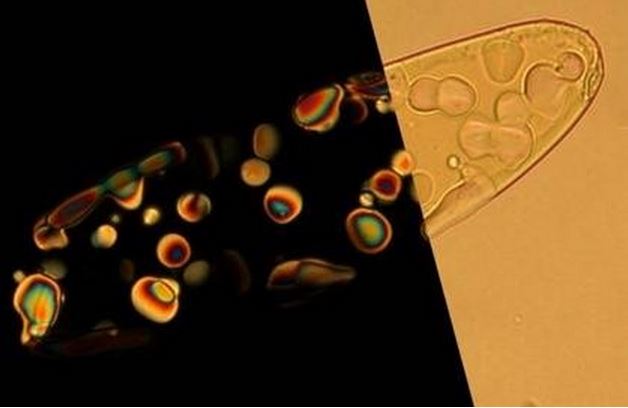Life on Earth may have begun spontaneously four billion years ago from self-organizing fragments of DNA-like molecules, American and Italian researchers suggest. Scientists know about single-celled organisms dating back to about 3.5 to 3.8 billion years ago, but have very little idea about what preceded their evolution.
In a study led by Tommaso Bellini of the University of Milan, researchers suggest that the self-organization properties of DNA-like molecular fragments about four billion years ago may have driven their own growth into repeating chemical chains long enough to act as the basis for primitive life.
The new findings of this latest study have been published in the academic journal Nature Communications (citation below).

A droplet of condensed nano-DNA and within it smaller drops of its liquid crystal phase which show up in polarized light on the left. The liquid crystal droplets act as “micro-reactors” where short DNA can join together into long polymer chains without the aid of biological mechanisms. (Image: courtesy Noel Clark, University of Colorado)
Co-author, physics professor Neol Clark, who works at the University of Colorado, Boulder, says the new findings suggest a different scenario for the non-biological origins of nucleic acids, which are the building blocks of living organisms. DNA, RNA, mRNA and tRNA are types of nucleic acid.
In the 1980s, CU-Boulder Nobel laureate and Distinguished Professor Tom Cech and colleagues discovered RNA’s ability to chemically alter its own structure, which led to the development of the concept of an ‘RNA world’ in which primordial life was a pool of RNA chains able to synthesize other chains from simpler molecules available in the environment.
A viable alternative to how life started
While most origin-of-life scientists agree that RNA chains are too specialized to have been created as the result of random chemical reactions, the new findings offer a viable alternative, said Prof. Clark.
Their latest study showed that the spontaneous self-assembly of tiny DNA fragments just a few nanometers in length into ordered liquid crystal phases can drive the formation of chemical bonds that connect together short DNA chains to form longer ones, without the need for any biological mechanisms.
Liquid crystals are substances which flow like a liquid but have some degree of ordering in the arrangement of their molecules, i.e. they may flow like a liquid but their molecules are oriented more like a crystal.
Prof. Clark said:
“Our observations are suggestive of what may have happened on the early Earth when the first DNA-like molecular fragments appeared.”
The research team has spent the past few years exploring the hypothesis that the way in which DNA emerged about four billion years ago lies in its structural properties and its capacity for self-organization.
In pre-RNA Earth, the spontaneous self-assembly of nucleic acid fragments (RNA and DNA) may have acted as a template for their chemical joining into polymers, which are substances which have molecular structures built up mainly or completely from a large number of similar units bonded together, i.e. a large number of repeating units.
Prof. Clark said:
“The new findings show that in the presence of appropriate chemical conditions, the spontaneous self-assembly of small DNA fragments into stacks of short duplexes greatly favors their binding into longer polymers, thereby providing a pre-RNA route to the RNA world.”
Citation: “Abiotic ligation of DNA oligomers templated by their liquid crystal ordering,” Tommaso P. Fraccia, Gregory P. Smith, Giuliano Zanchetta, Elvezia Paraboschi, Yougwooo Yi, David M. Walba, Giorgio Dieci, Noel A. Clark & Tommaso Bellini. Nature Communications. DOI: 10.1038/ncomms7424.

